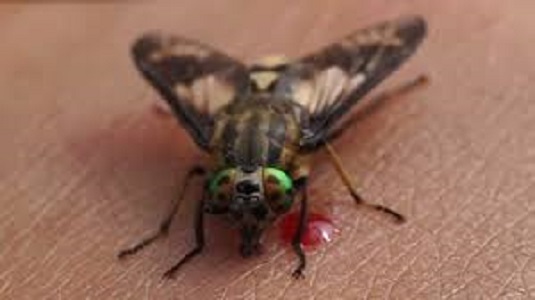
It tends to happen every summer here on the coast. You’re enjoying your time outside when all of a sudden you’re under attack: biting flies. Biting flies can be voracious eaters and will gladly get their blood meals from humans and animals. These bites are annoying, they can be very painful, and can even spread diseases. That’s why it’s important to know about the different kinds of biting flies you’ll find at the beach in Mississippi and what makes them bite people.
Types of Flies that Will Bite in Mississippi
It’s more than just one type of fly that bites. There are five main types of biting flies here on the Mississippi coast:
- No-see’ums
- Black flies
- Stable flies
- Horse flies
- Deer flies
Why Do Flies Bite People?
Flies are opportunistic eaters. Although they will gladly dine on decaying organic matter, garbage, and other unpleasant stuff, if a biting fly has access to humans or animals, it will bite to try to obtain a blood meal. Blood is very nutritious to flies. Unlike mosquitoes, flies do not require a blood meal to reproduce.
What Attracts Flies to Bite People?
Similar to mosquitoes, flies are highly reliant on their sense of smell. Any strong human smell — food, perfume, or personal smells — has the potential to attract biting flies.
How Can You Protect Yourself from Biting Flies in Mississippi?
Biting flies can be unavoidable at the height of summer. Still, there are a couple of things you can do to minimize your risk of getting bit.
- Limit your exposure: The less skin you have exposed, the harder it is for flies to bite you. Wear long sleeves if possible
- Bug spray: Consider using a bug spray with either DEET or picaridin. DEET is still the gold standard, but picaridin works quite well also and isn’t as harsh as DEET.
- Get out early: Flies are less active early in the morning, which is a great reason for you to be more active at that time.
Need Fly Control Services?
Learn More About the Biting Flies You’ll Find on the Mississippi Coast
We deal with several biting fly species here on the Gulf Coast and it’s worth knowing the differences so you know what your next steps should be.
No-See’Um
No-see’ums are members of the insect order Diptera that undergo complete metamorphosis including the egg, larva, pupa, and adult forms. The adults are less than 1/16-inch-long, dark gray to black, and have one pair of spotted wings. Although no-see’ums breed predominantly in salt marshes, some inland species breed in tree holes and other freshwater areas.
The larvae of this pest are often found in mud, sand, and other moist debris surrounding the edges of ponds, springs, lakes, creeks, tree holes, or slime-covered bark. In the water, larvae occur as free-living swimmers that are commonly found on floating twigs or leaf debris.
Black Fly
Black flies (Simuliidae) are small, dark, stout-bodied insects with a hump-backed appearance that can be biting flies. Adult females are not host-specific and feed on blood primarily during daylight hours. It hovers about the eyes, ears, and nostrils of man and animals, often alighting and puncturing the skin causing severe irritation.
The black fly life cycle begins when eggs are deposited on logs, rocks, or solid surfaces in swiftly flowing, oxygenated streams. Larvae attach themselves to underwater rocks or vegetation with a posterior sucker. The length of the larval period varies depending on the species and conditions within the larval environment. Adult black flies emerge after pupation and begin searching for new hosts. These pests are strong fliers and are known to travel seven to 10 miles from their breeding sites.
Stable Fly
The stable fly, also known as the dog fly, is a blood-sucking pest that closely resembles the house fly. It is similar to the house fly in size and color but is easily recognized by its large, piercing mouthparts, which project forward from the head. Unlike many blood-feeding insects, such as mosquitoes, both sexes of the stable fly feed on blood.
The stable fly is a common pest of man and animals throughout the world. Stable flies are strong fliers that can travel up to two miles in search of a blood meal. Because they are persistent and easily interrupted during feeding, they often attack more than one host, increasing the potential for disease transmission. Although stable flies may be mechanical vectors of several animal diseases, they are not known to play a significant role in spreading human pathogens.
Horse Fly and Deer Fly
Horse flies and deer flies are closely related insects with similar life cycles. Both pests are strong fliers and only the adult female bites. They are daytime feeders that use large piercing mouthparts to lacerate host skin for a blood meal. While feeding, an anticoagulant is injected into the wound, increasing blood flow. These wounds can often serve as sites for secondary infections and many people are allergic to the feeding activities of these pests. In addition, horseflies and deer flies are important agents of disease transmission due to their intermittent feeding activity.
Most species of horse flies and deer flies have aquatic or semi-aquatic immature stages. Some will also develop in moist soil, leaf debris, or rotting logs. The eggs are generally deposited in layers of vegetation, objects over water, or other moist areas favorable to larval development. Five to seven days after hatching, the larvae travel to the water surface or other moist areas and begin to feed on organic matter.
Fly Control Experts in Mississippi Gulf Coast
We at Southern Pest Control hope that this information was helpful. If you’re at the stage where it’s time to take action, we can help.
We’ve been providing outstanding fly control services to the good people of the Gulf Coast Region for over 38 years, and we’re ready to serve you. Call us today to schedule your appointment.
